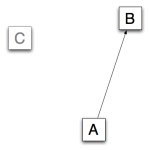Web sites are easy
When I start a new project, particularly with a new customer, I pay close attention to how they use the term web site. Customers arrive wanting a web site. They walk out with a digital solution. The web site is the easy bit. The hard part is defining, creating and rolling out a digital solution specifically for them.
 So what is a digital solution? For me, its a dynamic map that continually adapts as you journey through a project. A bit like Harry Potter’s Marauders Map. Sometimes it actually feels like we’re using the map to guide our customers through the project pitfalls but without the protection of the invisibility cloak. So to be clear, a digital solution takes a customer from what they want to what they need. And for me, this is the key differentiators between happy and unhappy customers.
So what is a digital solution? For me, its a dynamic map that continually adapts as you journey through a project. A bit like Harry Potter’s Marauders Map. Sometimes it actually feels like we’re using the map to guide our customers through the project pitfalls but without the protection of the invisibility cloak. So to be clear, a digital solution takes a customer from what they want to what they need. And for me, this is the key differentiators between happy and unhappy customers.
Now people have been creating, redeveloping, re-skinning web sites for over 20 years. Once you find the right people, they can do that until the cows come home. Building web sites is known technical challenge. But executing somebody else’s (business) vision, well that’s a people thing. It requires a clear strategy, with input from multi sources, to increase its likelihood for success. So let’s take the building of web sites out of the picture, the execution, and step upstream into the strategy, and see what happens there.

The Dynamic Strategy
Take a look at the picture opposite. Whenever a project kicks off, there is a vision. You’re told,
“we’re currently at A and want to get to B“. Simple. Only where they really need to be is at C. But they don’t know that yet.
In the majority of cases A and B are not very well defined. That’s okay, a bit of work and that can be sorted out. However, whilst you’re doing this, you really ought to be looking for C. In doing so, both the vision and strategy need to be adapt accordingly to uncover the digital solution. Remember the Marauders Map. Both the map itself (vision) and the journey (strategy) are changing as we learn more about our where we are and what we need.
But what happens today…
A digital solution typically starts with a customer vision. Next, a number of third parties are engaged to help build out a strategy. I get involved, sadly always too late, to execute on the strategy to deliver the vision. It’s a bit like ground hog day, walking into war zone and trying to make sense of the situation. It starts with the hundred questions. It’s no wonder I’m known by many customers as the ‘The Question Man’:
- What is your content strategy?
- Who is responsible for the creative?
- Do you have content life-cycle?
- What is your SEO policy, accessibility requirements?
- Is this multi-site, multi-lingual?
- Just how many agencies have you got involved in this?
- Do you have results of the usability study?
- Have you chosen a content management system?
- Will we be migrating existing content?
- Do your authors need to start entering content before the system is ready?
- What is your URL strategy?
- Do you have a retention policy?
- Who’s responsible the HTML production?
- Can I see some templates/pages with actual content please?
- and the list goes on…
Fortunately, I don’t just come with questions. I bring answers and/or a means to tease them out. After all, what value is someone that just asks questions! That said, on a good day, the execution phase is re-aligned based upon the answers provided. Sometimes this is major, other times its not. On a bad day, you have to make do. That is something I’ll pick up on different post.
What would be nice?
- If the vision, strategy and execution phase were not waterfall in their approach.
- That the vision was communicated clearly to ALL parties.
- For everyone to recognise that the strategy is an ongoing endeavour and not a dead document.
- For IT to be involved in the strategy, but not influencing it.
- For content strategists, to own and drive the content strategy. This should be a no brainer but its not!
- For digital solutions to be more content led, than design led.
- For the industry to be aware of what a good and bad content strategy feels like.
Wrap Up
I’m not saying web sites are not important. They are. It’s how people interact with you online. However, building them does not require dark magic. Yet the effort required to roll them out still does. This should not be the case today. We need to step up and get our heads out of the execution phase and start demanding access to better defined strategies that are founded upon clearly communicated visions. Lets give the ‘why’ to the people that actually build the web sites. Lets work together on that digital solution. And maybe, just maybe, they’ll meet your needs.


